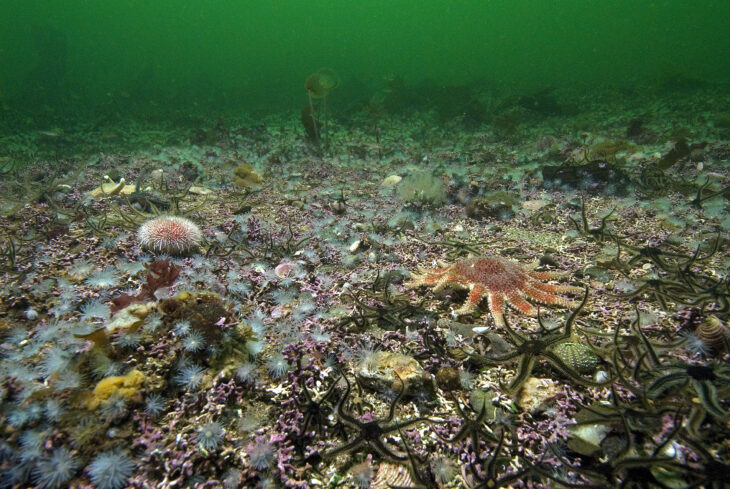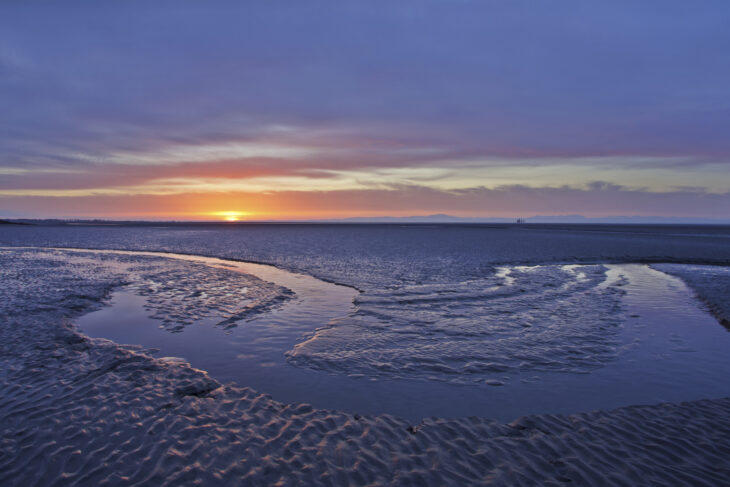WWF, Scottish Wildlife Trust and RSPB Scotland are calling for urgent strengthening of marine protections as a landmark report published today provides the most comprehensive estimate of carbon stored in Scotland’s seabed habitats.
The report is part of The Blue Carbon Mapping Project, completed by the Scottish Association for Marine Science (SAMS) on behalf of WWF-UK, The Wildlife Trusts and the RSPB. The series of reports mean the UK is the first nation to map and estimate the amount of carbon stored in its seabed habitats, including within Marine Protected Areas (MPAs).
Scotland’s seas make up more than 70% of the UK’s seas. This vast area is host to different habitats that capture and store carbon, known as ‘blue carbon’. They include seabed sediments (made of mud, silt and sand), seagrass meadows, saltmarshes and kelp forests.
The report reveals that 152 million tonnes of organic carbon are stored in just the top 10cm of seabed sediments – principally made of mud – in Scotland’s seas. 99% of this carbon is stored in seabed sediments.
Scotland’s seabed habitats could capture up to 9.5 million tonnes of organic carbon every year – over four times the amount sequestered by Scottish forests – 2.07 million tonnes – although forests cover a much smaller area (15,110 km2).

The Scottish government is currently consulting on fisheries management measures for offshore Marine Protected Areas and today’s report will provide an invaluable tool to help guide those protections. The report indicates that an estimated 60 million tonnes of organic carbon is held within the 20 sites being discussed – the equivalent to nearly 40% of the total organic carbon in Scottish Seas – adding further evidence for the need to protect them from bottom towed fishing disturbance.
Carbon is primarily absorbed by phytoplankton, which drift to the bottom of the sea when they die and are added to seabed sediment. The research analysed the storage capacity of just the top 10cm of sediment. Some sediments are hundreds of metres thick and contain millennia’s worth of carbon, so the total carbon stored will be far greater.
The Blue Carbon Mapping Project highlights how physical disturbances to the seabed, including from human activity such as bottom trawling, pose threats to blue carbon stores. Disturbing seabed habitats can release large amounts of carbon into the atmosphere, worsening climate change.
WWF, The Wildlife Trusts, and the RSPB are calling on governments across the UK to strengthen protections for valuable blue carbon stores – including in MPAs – by minimising the impacts of human activities on the seabed. Most MPAs were not designated to protect blue carbon, and failing to protect these areas from disturbance could threaten climate and biodiversity goals – including net-zero and protecting 30% of seas by 2030.
WWF-UK, The Wildlife Trusts & RSPB call for:
Better management of MPAs
- Ensure that all MPAs are protected from destructive activities that damage blue carbon habitats and threaten marine life.
- Account for both carbon and biodiversity in designating new protected areas, to support ecosystem resilience and the role seas play in climate mitigation.
- That the Scottish government adopts a site wide approach to managing damaging fishing activity across the offshore MPAs that are currently being consulted on.
Improved strategic planning of activities in UK seas
- Consider blue carbon in UK marine plans, avoiding damaging activities in MPAs and other key areas for blue carbon and wildlife that are not protected.
- Minimise the impacts of fishing and developments by undertaking blue carbon impact assessments.
- Support a just transition for fishing industries away from activities that damage the seabed.
More investment and research on protecting blue carbon
- Allocate funding to restore habitats including seagrass beds and saltmarshes.
- Support research and monitoring of blue carbon dynamics.
- Add seagrass and saltmarsh to the Greenhouse Gas Registry to track and monitor emissions.

Dr Lyndsey Dodds, ocean recovery policy manager at WWF Scotland, says:
“This report highlights the vital role our seas play in locking away carbon, and the need to protect them. We currently have an opportunity to strengthen the management of twenty of our offshore Marine Protected Areas through a government consultation. These twenty sites contain nearly 40% of Scotland’s organic carbon store, and we are asking for the restriction of unsustainable fishing activity that can potentially disturb this important resource. This essential step must be taken as part of our efforts to tackle the nature and climate emergency, while providing support to fishers to transition away from damaging fishing practices.”
Dr Jessica Jones, Marine Policy Manager at Scottish Wildlife Trust, says: “This world-first report further reveals the immense value of Scotland’s seas, a vital part of the broader UK marine ecosystem, while highlighting that many areas need far stronger protection. Government needs to respond with urgency and consistency to minimise the impacts of activities which harm the seabed and protect areas based on their value for both wildlife and carbon. Involving communities in safeguarding our seas, strategically protecting our seas through marine planning and restricting activities within protected areas that are designated to protect seabed features is essential for ensuring a positive future for marine wildlife whilst leveraging powerful natural tools to tackle climate change. We envision Scotland, and the other governments of the UK, leading the world in protecting blue carbon and biodiversity.”
Helen McLachlan, Head of Marine Policy at RSPB Scotland, says: “Scotland’s seas make up around two thirds of UK waters and today’s report highlights that they have a key role to play as we work to halt declines in our wildlife and meet net-zero. Restoring marine habitats, effectively planning and delivering offshore development, and investing in and robustly managing and monitoring protected areas are all essential to safeguard threatened and important species, like Scotland’s iconic seabirds, and keep blue carbon locked up.”
Professor Mike Burrows, Scottish Association for Marine Science, says: “Understanding how much and where our marine carbon is stored is vital for guiding efforts to maintain and protect the capacity of coastal and seabed habitats to continue to serve this function. Saltmarshes and seagrass beds are significant carbon storage hotspots, while kelp beds and especially phytoplankton contribute large amounts of organic carbon annually. However, the exact fraction of this carbon that is stored in sediments remains uncertain. By consolidating various information sources, we have gained valuable insights into our coastal seabed. This process has also highlighted significant gaps in our knowledge regarding the rates of carbon accumulation in sediments.”
The full report and technical summary can be found on The Wildlife Trusts website.
*Please note that organic carbon should not be converted into carbon dioxide equivalent in this instance due to the complex interaction of atmospheric carbon and the ocean.
